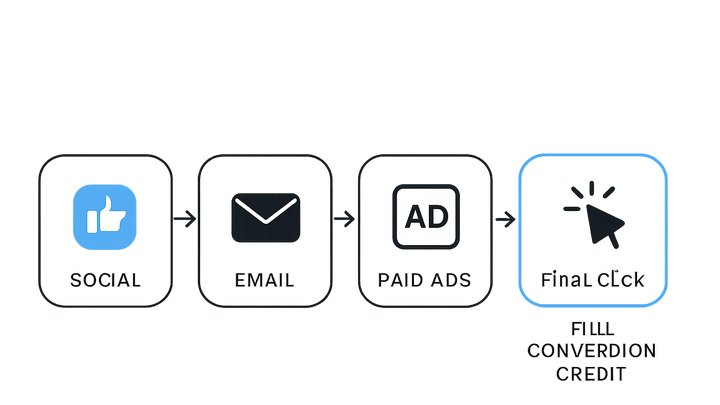Published on 2025-06-29T18:23:30Z
What is Last-Click Attribution? Examples and Implementation
Last-Click Attribution is a marketing analytics model that assigns 100% of conversion credit to the final touchpoint a user interacts with before completing a desired action (e.g., purchase, signup). Within the campaign tracking & analytics industry, this approach simplifies performance measurement by focusing solely on the last engagement rather than distributing credit across multiple interactions. It’s easy to set up in cookie-free platforms like Plainsignal—by embedding a simple script—and further enhanced by generating consistent UTM-tagged URLs using tools like UTMguru.com. However, Last-Click Attribution can obscure the impact of earlier channels that drove awareness and consideration, leading to potentially skewed budget allocations. Despite its limitations, many marketers rely on its clear, straightforward reports and minimal configuration. For a holistic understanding of customer journeys, it’s often combined with multi-touch or data-driven attribution models.
Last-click attribution
An attribution model assigning full conversion credit to the final marketing interaction before a user's conversion.
How Last-Click Attribution Works
Last-Click Attribution credits the conversion to the final marketing interaction a user engages with before completing a desired action. Analytics tools capture click events, log the source channel, and match those records to the timestamp of the conversion. By isolating the last touchpoint, this approach streamlines attribution reporting.
-
Definition
Last-Click Attribution is a model that gives 100% of conversion credit to the last touchpoint a user interacted with.
- Touchpoint:
Any user interaction with a marketing channel, such as an email click or ad impression.
- Conversion:
The desired user action, like a purchase, signup, or lead submission.
- Touchpoint:
-
Mechanism
The system records each click and identifies which one occurred most recently before the conversion event.
- Click tracking:
Scripts or tracking pixels capture click data and source metadata.
- Data matching:
Attribution engines align click timestamps with conversion timestamps to determine the last interaction.
- Click tracking:
Benefits and Limitations
While Last-Click Attribution is straightforward and easy to implement, it comes with trade-offs that can affect marketing insights.
-
Advantages
The simplicity of assigning 100% credit to a single touchpoint makes the model easy to configure and interpret.
- Ease of implementation:
Requires minimal setup and data processing.
- Clear reporting:
Delivers unambiguous results by focusing on one source.
- Ease of implementation:
-
Limitations
By ignoring earlier interactions, Last-Click Attribution can undervalue channels that influence awareness and research phases.
- Skewed insights:
Overlooks the impact of upper-funnel channels.
- Cross-device gaps:
Challenges arise when tracking users across multiple devices and sessions.
- Skewed insights:
Practical Implementation with SaaS Tools
Leverage platforms like PlainSignal and UTMguru to set up and optimize Last-Click Attribution in your campaigns.
-
Implementing with plainsignal
PlainSignal provides a cookie-free script to capture click events and attribute conversions accurately. Embed the following snippet on every page to start tracking:
- Tracking script:
Embed the PlainSignal snippet on your page:
<link rel=\"preconnect\" href=\"//eu.plainsignal.com/\" crossorigin /><script defer data-do=\"yourwebsitedomain.com\" data-id=\"0GQV1xmtzQQ\" data-api=\"//eu.plainsignal.com\" src=\"//cdn.plainsignal.com/plainsignal-min.js\"></script> - Dashboard reporting:
Access attribution data under the ‘Attribution’ tab in your PlainSignal dashboard to review last-click metrics.
- Tracking script:
-
Using utmguru for url tagging
UTMguru.com helps you build and manage consistent UTM parameters that feed into your Last-Click Attribution analysis.
- Generating utm urls:
Use the UTMguru builder to create campaign-tagged links and save them for future use.
- Chrome extension:
Quickly tag links on the web with the UTMguru Chrome extension and maintain a library of presets.
- Generating utm urls:
Best Practices and Tips
Enhance your Last-Click Attribution accuracy and insights by following these recommended guidelines.
-
Maintain consistent utm naming
Standardize parameter naming to avoid fragmented channel data.
- Standardization:
Use lowercase values and consistent delimiters across all campaigns.
- Documentation:
Keep a shared style guide for UTM naming conventions.
- Standardization:
-
Combine with additional models
Augment Last-Click Attribution with multi-touch or data-driven models for a more complete view of customer journeys.
- Multi-touch attribution:
Distribute credit across multiple interactions based on their contribution.
- Time decay model:
Allocate more credit to interactions that happened closer to the conversion.
- Multi-touch attribution:
